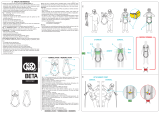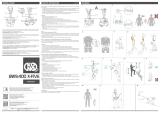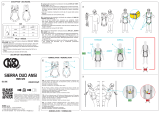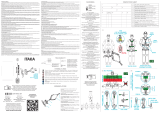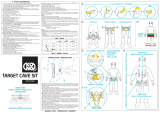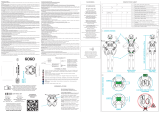Seite wird geladen ...

EN - (A) Shoulder straps, (B) Sit harnesses, (C) Dorsal attachment point, (D) Sternal attachment
point, (E) Quick-release adjustment buckle, (F) Sternal sling, (G) Polyethylene backplate, (H)
Adjustment buckles, (I) Quick-release adjustment buckle, (L) Nylon or polyester loops, (M)
Radio holder, (N) Gear loops.
Not otherwise specied materials: polyester (textile parts), carbon steel (metal parts).
IT - (A) Bretelle, (B) Cosciali, (C) Punto di attacco dorsale, (D) Punto di attacco sternale, (E)
Fibbia di regolazione con sgancio rapido, (F) Fettuccia sternale, (G) Schienalino in polietilene,
(H) Fibbie di regolazione, (I) Fibbia di regolazione con sgancio rapido, (L) Passanti in nylon/
poliestere, (M) Porta radio, (N) Porta-materiali.
Materiali non altrimenti specicati: poliestere (tessili), acciaio al carbonio (metallici).
FR - (A) Bretelles, (B) Cuissards, (C) Point d’attache dorsal, (D) Point d’attache sternal, (E)
Boucle de réglage à décrochage rapide, (F) Anneau de sangle sternal, (G) Plaque dorsale en
polyéthylène, (H) Boucles de réglage, (I) Boucle de réglage à décrochage rapide, (L) Passants
en nylon/polyester, (M) Porte radio, (N) Porte-matériels.
Matériau non autrement spécié : polyester (parties en tissu), acier au carbone (composants
en métal).
DE - (A) Brustgurte, (B) Beinschlaufen, (C) Rückenauffangöse, (D) Brustöse, (E) Schnallen
zur Größenregulierung mit Schnellöffnungsmechanismus, (F) Brustband, (G) Polyäthylen-
Rückenband, (H) Schnallen zur Größenregulierung, (I) Schnalle zur Größenregulierung mit
Schnellöffnungsmechanismus, (L) Schlaufen aus Nylon/Polyester, (M) Funkgeräthalterung, (N)
Materialschlaufen.
Nicht anderweitig spezizierte Materialien: Polyester (Textilien), Kohlenstoffstahl (Metallteile).
EN - The Personal Protective Equipment category III 8W9.900 HHO TURBO (g. 1) is:
- a full body harnesses for connection to fall arrest systems, tted with a dorsal attach-
ment point marked with the letter A and a sternal attachment point consisting in two
elements marked A/2;
- part of a system protecting against impact caused by fall from a height;
- certied according to the standard EN 361:02.
IT - I Dispositivi di Protezione Individuale di III categoria 8W9.900 HHO TURBO (g.
1) è:
- un’imbracatura completa per collegamento a sistemi di arresto caduta, provvista
di un punto di attacco dorsale contrassegnato dalla lettera A ed un punto di attacco
sternale formato da due elementi contrassegnati A/2;
- parte di un sistema di protezione dall’impatto derivante da cadute dall’alto;
- certicata in accordo allo standard EN 361:02.
FR - L’Équipement de Protection Individuelle de catégorie III 8W9.900 HHO TURBO
(g. 1) est:
- un harnais complets à attacher aux systèmes antichute, équipé d’un point d’attache
dorsal marqué de la lettre A et d’un point d’attache sternal composé de deux éléments
marqués A/2;
- partie d’un system de protection contre les chocs résultant de chutes de hauteur;
- certiés selon les normes EN 361:02,
DE - Die Persönliche Schutzausrüstung (PSA) in Kategorie III 8W9.900 HHO TURBO
(Abb. 1) ist:
- eine Ganzkörper-Auffanggurte für die Verbindung mit Auffangsystemen, mit ein
Rückenöse markiert mit dem Buchstaben A und ein zentraler Brustöse bestehend aus
zwei Anschlusselementen markiert mit A/2;
- Teil eines Systems, das vor Stößen schützt, die durch den Fall aus der Höhe verur-
sacht werden;
- zertiziert nach EN 361:02.
S M/L XL
A (cm) 60-95 72-105 89-130
B (cm) 40-60 50-62 62-80
(g) 850 850 900
SIZE • TAGLIA
TAILLE • GRÖSSE
3
6
7A
4 5
7B
E
DD
C
C
BACK UP
EN 353-2
or
EN 12841/A
ZZV05555 rev. 0
HHO TURBO
KONG s.p.a.
Via XXV Aprile, 4 - (zona industriale)
I - 23804 MONTE MARENZO (LC) - ITALY
Tel +39 0341630506 - Fax +39 0341641550 - [email protected]
8W9.900
NOMENCLATURE • TERMINOLOGIE
NOMENCLATURE • NOMENCLATURA
Stáhněte si překlad ve vašem jazyce - Laden Sie die Übersetzung in
Ihrer Sprache herunter - Download the translation in your language
- Bájate la traducción en tu idioma - Télécharger la traduction dans
vostre langue - Scarica la traduzione nella tua lingua - Download
de vertaling in je eigen taal - Pobierz tłumaczenie w twoim języku
- Faça o download da tradução no seu idioma - Скачайте перевод
на ваш язык - 下载您语言版本的手册
2
A
F
N
L
B
I
H
E
D
M
C
G
N
DESCRIPTION • DESCRIZIONE
DESCRIPTION • BESCHREIBUNG
1
EN 361
15 kN
A
EN 361
15 kN
A/2A/2
A

8 – SPECIFIC INFORMATION
Warning:
- a prolonged suspension onto a harness, especially in motionless con-
ditions, may cause the harness hang syndrome (or suspension trauma)
that can lead to loss of consciousness and even death!
- never connect just one attachment element (g. 7B): the sternal attach-
ment point (D) consists of two attachment elements marked by “A/2”.
Important: the harness is just a component of a fall arrest system, therefore
it shall be connected to other devices (i.e. shock absorbers, ropes, etc.) in
order to obtain a fall arrest system conforming to standard EN 363.
8.1 - Harness wearability
First of all check the size – choosing the correct one for you (see SIZE table).
To don the harness correctly:
a) loosen the slings in the buckles,
b) release the sternal buckle (E)
c) holding the harness by the dorsal attachment point (C), spread out the
shoulder straps (A) - g.3,
d) slip your legs into the sit harness (B),
e) slip your arms into the shoulder straps (A),
f) hook the sternal sling (F) – g. 4,
g) adjust the harness by tightening the slings (H) - g. 5,
h) position the loops (L) to hold the exceeding sling.
Important:
- before using the harness, nd a completely safe position and carry out
movements and suspension tests on each attachment point to make sure the
harness is adjusted properly and comfortable for your intended use,
- regularly check the closure of the adjustment buckles when in use.
8.2 - Use
Examples of a correct use with connection to the:
- dorsal attachment point (C) – g. 6,
- sternal attachment point (D) – g. 7A.
8.3 - Device carriage
While transporting the device adopt storage precautions (point 3) and avoid
exposition to direct sunlight and humidity.
9 - PRE AND POST USE CONTROLS
Before and after use make sure that the device is in efcient condition and
working properly, particularly check :
- textile parts do not show any signs of tear, burns, chemical residues,
excessive uff, wear. Pay special attention to the areas that contact metal
parts (buckles, rings, etc.),
- stitchings are undamaged and that there are no cut or loosen threads,
- buckles work properly (locking, adjustment and locking) and show no signs
of cracks, corrosion and mechanical deformation. Wear is acceptable as long
as it is just aesthetic.
- markings, labels included, are still readable.
8 – INFORMAZIONI SPECIFICHE
Attenzione:
- la sospensione prolungata sull’imbracatura, soprattutto se inerte, può
indurre la sindrome (o trauma) da sospensione che provoca perdita di
coscienza e anche morte!
- pericolo di morte! Non collegarsi mai ad un solo elemento di attacco
(g. 7B): il punto di attacco sternale (D) è formato dai due elementi di
attacco contrassegnati con A/2.
Importante: l’imbracatura è solo un componente di un sistema di arresto ca-
dute e come tale deve essere collegato ad altri dispositivi (es. assorbitori di
energia, corde, ecc.) per realizzare un sistema di arresto caduta conforme
alla norma EN 363.
8.1 - Vestibilità dell’imbracatura
Prima di indossare l’imbracatura vericare l’idoneità della taglia (vedere ta-
bella SIZE).
Per indossare correttamente l’imbracatura:
a) allentare le fettucce nelle bbie,
b) sganciare la bbia sternale (E),
c) sollevare l’imbracatura per il punto di attacco dorsale (C) ed allargare le
bretelle (A) - g.3,
d) inlare le gambe nei cosciali (B),
e) inlare le braccia nelle bretelle (A),
f) agganciare la bbia sternale (F) - g. 4,
g) regolare l’imbracatura tensionando le fettucce (H) - g. 5,
h) posizionare i passanti (L) per trattenere le eccedenze di fettuccia.
Importante:
- prima di utilizzare l’imbracatura, in posizione di assoluta sicurezza, effettuare
movimenti e prove di sospensione su ogni punto di attacco per accertarsi che
l’imbracatura sia correttamente regolata e comoda per l’utilizzo previsto,
- durante l’utilizzo controllare regolarmente la chiusura delle bbie di regola-
zione.
8.2 - Utilizzo
Esempi di corretto utilizzo con collegamento al:
- punto di attacco dorsale (C) – g. 6,
- punto di attacco sternale (D) – g. 7A.
8.3 – Trasporto del dispositivo
Durante il trasporto del dispositivo adottare le precauzioni per l’immagazzina-
mento (punto 3) ed evitare l’esposizione diretta alla luce del sole e l’umidità
9 - CONTROLLI PRE E POST USO
Prima e dopo l’uso assicurarsi che il dispositivo sia in condizioni efcienti e
funzioni correttamente, in particolare controllare che:
- le parti tessili non presentino tagli, bruciature, residui di prodotti chimici,
eccessiva peluria, usura, in particolare vericate le zone in contatto con com-
ponenti metallici (bbie, anelli, ecc.),
- le cuciture siano integre e che non vi siano li tagliati o allentati,
- le bbie funzionino correttamente (bloccaggio, regolazione e bloccaggio),
che non abbiano cricche, tracce di corrosione, deformazioni meccaniche e
che l’eventuale usura sia esclusivamente di carattere estetico.
- le marcature, comprese le etichette, siano ancora leggibili.
8 – INFORMATIONS PARTICULIÈRES
Attention:
- la suspension prolongée dans le harnais, surtout lorsqu’inerte, peut
provoquer le syndrome (ou trauma) de suspension qui cause une perte
de conscience et même la mort!
- ne jamais s’attacher à un seul élément d’attache (g. 7B): le point d’at-
tache sternal (D) est formé des deux éléments d’attache marqués par A/2.
Important: le harnais est seulement le composant d’un système d’arrêt
de chutes et, comme tel, il doit être joint à d’autres dispositifs (par ex..
absorbeurs d’énergie, cordes, etc.) an de muter en un système d’arrêt de
chutes conforme à la norme EN 363.
8.1 - Simplicité de port du harnais
Avant de mettre le harnais, vérier que la taille soit idoine (voir le tableau
SIZE).
Pour vêtir correctement le harnais :
a) desserrer les anneaux de sangle dans les boucles,
b) décrocher la boucle sternale (E),
c) soulever le harnais par le point d’attache dorsal (C) et écarter les bretelles
(A) – g. 3,
d) enler les jambes dans les cuissards (B),
e) enler les bras dans les bretelles (A),
f) accrocher la boucle sternale (F) - g. 4,
g) régler le harnais en tirant sur les anneaux de sangle (H) – (g. 5),
h) placer les passants (L) pour retenir l’anneau de sangle excédant.
Important :
- avant d’utiliser le harnais en position de sécurité absolue, exécuter des
mouvements et des essais de suspension sur chaque point d’attache pour
s’assurer que le harnais soit réglé correctement et qu’il soit confortable pour
l’emploi prévu,
- pendant l’emploi, vérier régulièrement la fermeture des boucles de réglage.
8.2 - Emploi
Exemples d’emploi correct avec jonction au :
- point d’attache dorsal (C) – g. 6,
- point d’attache sternal (D) – g. 7A.
8.3 – Transport de l’équipement
Lors du transport de l’équipement, tenir compte des précautions prévues pour
l’entreposage (point 3) et limiter l’exposition directe à la lumière du soleil et
à l’humidité.
9 - CONTRÔLES AVANT ET APRÈS L’EMPLOI
Avant et après l’emploi, s’assurer que l’équipement soit dans des conditions
efcaces et qu’il fonctionne correctement; s’assurer notamment que:
- les parties textiles n’aient aucun signe de coupure, brûlure, résidus de
produits chimiques, un duvet excessif, de l’usure, vériez particulièrement les
zones en contact avec les composants en métal (boucles, anneaux, etc.),
- les coutures soient intactes et qu’il n’y ait pas de ls coupés ou lâches,
- les boucles fonctionnent correctement (blocage, réglage et blocage), qu’elles
ne présentent aucun signe de ssures, traces de corrosion, déformations
mécaniques et que l’usure éventuelle soit exclusivement à caractère
esthétique,
- les marquages, y compris les étiquettes, soient lisibles.
8 – SPEZIFISCHE INFORMATIONEN
Achtung:
- längeres Hängen im Auffanggurt, vor allem wenn man sich nicht be-
wegt, kann zum Hängesyndrom (oder Trauma) führen, das Bewusstlo-
sigkeit und auch Tod verursachen kann!
- sich niemals nur an einem Anschlagelement anschließen (Abb. 7B):
Die Brustöse (D) besteht aus zwei Anschlagelementen, die mit A/2
markiert sind.
Wichtig: der Auffanggurt ist nur ein Bestandteil eines Auffangsystems und
muss als solches an andere Vorrichtungen angeschlossen werden (z.B.
Aufpralldämpfer, Seile usw.), um ein Auffangsystem nach EN 363 zu bilden.
8.1 – Tragbarkeit des auffanggurts
Vor dem Anziehen des Auffanggurts die richtige Größe prüfen (siehe Tabelle
SIZE).
Zum richtigen Anziehen des Auffanggurts:
a) Die Bänder in den Schnallen lockern,
b) Die Brustschnalle (E) lösen,
c) Den Auffanggurt an der Rückenauffangöse (C) anheben und die Brustgurte
(A) weiter machen – Abb.3,
d) Die Beine in die Beinschlaufen (B) stecken,
e) Die Arme in die Brustgurte (A) stecken,
f) Die Brustschnalle einhängen (F) - Abb. 4,
g) Den Auffanggurt durch Anziehen der Bänder (H) einstellen – Abb. 5,
h) Die Schlitzschnallen (L) positionieren, um überschüssiges Band zu
befestigen.
Wichtig:
- Vor dem Gebrauch des Auffanggurts in absolut sicherer Position
Bewegungen und Tests für das Hängen bei jedem Anschlagpunkt ausführen
um sicherzustellen, dass der Auffanggurt richtig eingestellt und für den
vorgesehenen Gebrauch bequem ist,
- Während des Gebrauchs regelmäßig den Verschluss der Schnallen zur
Größenregulierung prüfen.
8.2 – Gebrauch
Beispiel der richtigen Anwendung mit Verbindung an:
- Rückenöse (C) – Abb. 6,
- Brustöse (D) – Abb. 7A.
8.3 – Transport der Vorrichtung
Beim Transport der Vorrichtung die für die Lagerung genannten
Vorsichtsmaßnahmen (Punkt 3) berücksichtigen und die direkte
Sonnenbestrahlung und Feuchtigkeitseinwirkung begrenzen.
9 – KONTROLLEN VOR UND NACH DEM GEBRAUCH
Vor und nach dem Gebrauch sicherstellen, dass die Vorrichtung einsatzfähig
und betriebstüchtig ist. Insbesondere kontrollieren, dass:
- die textilen Teile keine Schnitte, Verbrennungen, Reste von Chemikalien, zu
starke Fusselbildung, Verschleiß aufweisen und insbesondere die Bereiche
in Kontakt mit Metallkomponenten prüfen (Schnallen, Ringe usw.),
- die Nähte unversehrt sind und keine geschnittene oder lockere Fäden
aufweisen,
- die Schnallen richtig funktionieren (Klemmung, Regulierung und Klemmung),
keine Risse, Korrosionsspuren, mechanische Verformungen aufweisen und
dass ggf. vorliegender Verschleiß ausschließlich ästhetischen Charakters ist,
- die Markierungen einschließlich der Etiketten lesbar sind.
EN
Master text: ITALIAN Teste de référence: ITALIENNE Referenztext: ITALIENISCH
IT FR DE
NB n° 0123
TÜV SÜD Product
Service GmbH
Daimlerstraße 11
85748 Garching - Germany
Download the declarance of conformity at:
Scarica la dichiarazione di conformità a :
Télécharger la déclaration de conformité à:
Laden Sie die Konformitätserlärung herunter zu:
www.kong.it/conformity
100 KG / 1 X
CERTIFIED BY • CERTIFICATO DA
CERTIFIÉ PAR • ZERTIFIZIERT VON
MARKING • MARCATURA
MARKIERUNG • MARQUAGE
Conformity to European Norm
Conformità alla Norma Europea
Conforme à la norme européenne
Entspricht der Europäischen Norm
Attachment point for fall arrest systems
Punto di attacco per sistemi anticaduta
Point d‘attache pour systèmes antichute
Anschlagpunkt für Auffangsysteme
Attachment element
Elemento di attacco
Élément d’attache
Anschlagelement
Dorsal attachment point
Punto di attacco dorsale
Point d’attache dorsal
Rückenöse
Sternal attachment point
Punto di attacco sternale
Point d’attache sternal
Brustöse
Regulation and blocking of the webbing
Regolazione e bloccaggio delle fettucce
Réglage et blocage des anneaux de sangle
Regulieren und Klemmen der Bänder
EN 361:02 A A/2
Authorised load and number of persons for EASA use
Carico autorizzato e numero di persone per uso EASA
Charge autorisée et le nombre de personnes pour l’utilisation de l’AESA
Autorisierte Belastung und Anzahl der Personen für die EASA-Nutzung

EN - (A) Shoulder straps, (B) Sit harnesses, (C) Dorsal attachment point, (D) Sternal attachment
point, (E) Quick-release adjustment buckle, (F) Sternal sling, (G) Polyethylene backplate, (H)
Adjustment buckles, (I) Quick-release adjustment buckle, (L) Nylon or polyester loops, (M)
Radio holder, (N) Gear loops.
Not otherwise specied materials: polyester (textile parts), carbon steel (metal parts).
IT - (A) Bretelle, (B) Cosciali, (C) Punto di attacco dorsale, (D) Punto di attacco sternale, (E)
Fibbia di regolazione con sgancio rapido, (F) Fettuccia sternale, (G) Schienalino in polietilene,
(H) Fibbie di regolazione, (I) Fibbia di regolazione con sgancio rapido, (L) Passanti in nylon/
poliestere, (M) Porta radio, (N) Porta-materiali.
Materiali non altrimenti specicati: poliestere (tessili), acciaio al carbonio (metallici).
FR - (A) Bretelles, (B) Cuissards, (C) Point d’attache dorsal, (D) Point d’attache sternal, (E)
Boucle de réglage à décrochage rapide, (F) Anneau de sangle sternal, (G) Plaque dorsale en
polyéthylène, (H) Boucles de réglage, (I) Boucle de réglage à décrochage rapide, (L) Passants
en nylon/polyester, (M) Porte radio, (N) Porte-matériels.
Matériau non autrement spécié : polyester (parties en tissu), acier au carbone (composants
en métal).
DE - (A) Brustgurte, (B) Beinschlaufen, (C) Rückenauffangöse, (D) Brustöse, (E) Schnallen
zur Größenregulierung mit Schnellöffnungsmechanismus, (F) Brustband, (G) Polyäthylen-
Rückenband, (H) Schnallen zur Größenregulierung, (I) Schnalle zur Größenregulierung mit
Schnellöffnungsmechanismus, (L) Schlaufen aus Nylon/Polyester, (M) Funkgeräthalterung, (N)
Materialschlaufen.
Nicht anderweitig spezizierte Materialien: Polyester (Textilien), Kohlenstoffstahl (Metallteile).
EN - The Personal Protective Equipment category III 8W9.901 HHO TURBO FR (g.
1) is:
- a full body harnesses for connection to fall arrest systems, tted with a dorsal at-
tachment point marked with the letter A and a sternal attachment point consisting in
two elements marked A/2;
- made in self-extinguishing and non-propagating tape according to standard
UNI8456 category 3;
- part of a system protecting against impact caused by fall from a height;
- certied according to standard EN361:02.
IT - I Dispositivi di Protezione Individuale di III categoria 8W9.901 HHO TURBO FR
(g. 1) è:
- un’imbracatura completa per collegamento a sistemi di arresto caduta, provvista
di un punto di attacco dorsale contrassegnato dalla lettera A ed un punto di attacco
sternale formato da due elementi contrassegnati A/2;
- composta da nastri autoestinguenti e non propaganti in accordo allo standard
UNI8456 categoria 3;
- parte di un sistema di protezione dall’impatto derivante da cadute dall’alto;
- certicata in accordo allo standard EN361:02.
FR - L’Équipement de Protection Individuelle de catégorie III 8W9.901 HHO TURBO
FR (g. 1) est:
- un harnais complets à attacher aux systèmes antichute, équipé d’un point d’atta-
che dorsal marqué de la lettre A et d’un point d’attache sternal composé de deux
éléments marqués A/2;
- fabriqué en bande auto-extinguible et non propagative selon la norme UNI8456
catégorie 3;
- partie d’un system de protection contre les chocs résultant de chutes de hauteur;
- certiés selon les normes EN361:02,
DE - Die Persönliche Schutzausrüstung (PSA) in Kategorie III 8W9.901 HHO TUR-
BO FR (Abb. 1) ist:
- eine Ganzkörper-Auffanggurte für die Verbindung mit Auffangsystemen, mit ein
Rückenöse markiert mit dem Buchstaben A und ein zentraler Brustöse bestehend
aus zwei Anschlusselementen markiert mit A/2;
- hergestellt in selbstverlöschendem und nicht-propagierendem Band gemäß der
Norm UNI8456 Kategorie 3;
- Teil eines Systems, das vor Stößen schützt, die durch den Fall aus der Höhe ver-
ursacht werden;
- zertiziert nach EN361:02.
S M/L XL
A (cm) 60-95 72-105 89-130
B (cm) 40-60 50-62 62-80
(g) 850 850 900
SIZE • TAGLIA
TAILLE • GRÖSSE
3
6
7A
4 5
7B
E
DD
C
C
BACK UP
EN 353-2
or
EN 12841/A
ZZV05554 rev. 0
HHO TURBO FR
KONG s.p.a.
Via XXV Aprile, 4 - (zona industriale)
I - 23804 MONTE MARENZO (LC) - ITALY
Tel +39 0341630506 - Fax +39 0341641550 - [email protected]
8W9.901
NOMENCLATURE • TERMINOLOGIE
NOMENCLATURE • NOMENCLATURA
Stáhněte si překlad ve vašem jazyce - Laden Sie die Übersetzung in
Ihrer Sprache herunter - Download the translation in your language
- Bájate la traducción en tu idioma - Télécharger la traduction dans
vostre langue - Scarica la traduzione nella tua lingua - Download
de vertaling in je eigen taal - Pobierz tłumaczenie w twoim języku
- Faça o download da tradução no seu idioma - Скачайте перевод
на ваш язык - 下载您语言版本的手册
2
A
F
N
L
B
I
H
E
D
M
C
G
N
DESCRIPTION • DESCRIZIONE
DESCRIPTION • BESCHREIBUNG
1
EN 361
15 kN
A
EN 361
15 kN
A/2A/2
A

8 – SPECIFIC INFORMATION
Warning:
- a prolonged suspension onto a harness, especially in motionless con-
ditions, may cause the harness hang syndrome (or suspension trauma)
that can lead to loss of consciousness and even death!
- never connect just one attachment element (g. 7B): the sternal attach-
ment point (D) consists of two attachment elements marked by “A/2”.
Important: the harness is just a component of a fall arrest system, therefore
it shall be connected to other devices (i.e. shock absorbers, ropes, etc.) in
order to obtain a fall arrest system conforming to standard EN 363.
8.1 - Harness wearability
First of all check the size – choosing the correct one for you (see SIZE table).
To don the harness correctly:
a) loosen the slings in the buckles,
b) release the sternal buckle (E)
c) holding the harness by the dorsal attachment point (C), spread out the
shoulder straps (A) - g.3,
d) slip your legs into the sit harness (B),
e) slip your arms into the shoulder straps (A),
f) hook the sternal sling (F) – g. 4,
g) adjust the harness by tightening the slings (H) - g. 5,
h) position the loops (L) to hold the exceeding sling.
Important:
- before using the harness, nd a completely safe position and carry out
movements and suspension tests on each attachment point to make sure the
harness is adjusted properly and comfortable for your intended use,
- regularly check the closure of the adjustment buckles when in use.
8.2 - Use
Examples of a correct use with connection to the:
- dorsal attachment point (C) – g. 6,
- sternal attachment point (D) – g. 7A.
8.3 - Device carriage
While transporting the device adopt storage precautions (point 3) and avoid
exposition to direct sunlight and humidity.
9 - PRE AND POST USE CONTROLS
Before and after use make sure that the device is in efcient condition and
working properly, particularly check :
- textile parts do not show any signs of tear, burns, chemical residues,
excessive uff, wear. Pay special attention to the areas that contact metal
parts (buckles, rings, etc.),
- stitchings are undamaged and that there are no cut or loosen threads,
- buckles work properly (locking, adjustment and locking) and show no signs
of cracks, corrosion and mechanical deformation. Wear is acceptable as long
as it is just aesthetic.
- markings, labels included, are still readable.
8 – INFORMAZIONI SPECIFICHE
Attenzione:
- la sospensione prolungata sull’imbracatura, soprattutto se inerte, può
indurre la sindrome (o trauma) da sospensione che provoca perdita di
coscienza e anche morte!
- pericolo di morte! Non collegarsi mai ad un solo elemento di attacco
(g. 7B): il punto di attacco sternale (D) è formato dai due elementi di
attacco contrassegnati con A/2.
Importante: l’imbracatura è solo un componente di un sistema di arresto ca-
dute e come tale deve essere collegato ad altri dispositivi (es. assorbitori di
energia, corde, ecc.) per realizzare un sistema di arresto caduta conforme
alla norma EN 363.
8.1 - Vestibilità dell’imbracatura
Prima di indossare l’imbracatura vericare l’idoneità della taglia (vedere ta-
bella SIZE).
Per indossare correttamente l’imbracatura:
a) allentare le fettucce nelle bbie,
b) sganciare la bbia sternale (E),
c) sollevare l’imbracatura per il punto di attacco dorsale (C) ed allargare le
bretelle (A) - g.3,
d) inlare le gambe nei cosciali (B),
e) inlare le braccia nelle bretelle (A),
f) agganciare la bbia sternale (F) - g. 4,
g) regolare l’imbracatura tensionando le fettucce (H) - g. 5,
h) posizionare i passanti (L) per trattenere le eccedenze di fettuccia.
Importante:
- prima di utilizzare l’imbracatura, in posizione di assoluta sicurezza, effettuare
movimenti e prove di sospensione su ogni punto di attacco per accertarsi che
l’imbracatura sia correttamente regolata e comoda per l’utilizzo previsto,
- durante l’utilizzo controllare regolarmente la chiusura delle bbie di regola-
zione.
8.2 - Utilizzo
Esempi di corretto utilizzo con collegamento al:
- punto di attacco dorsale (C) – g. 6,
- punto di attacco sternale (D) – g. 7A.
8.3 – Trasporto del dispositivo
Durante il trasporto del dispositivo adottare le precauzioni per l’immagazzina-
mento (punto 3) ed evitare l’esposizione diretta alla luce del sole e l’umidità
9 - CONTROLLI PRE E POST USO
Prima e dopo l’uso assicurarsi che il dispositivo sia in condizioni efcienti e
funzioni correttamente, in particolare controllare che:
- le parti tessili non presentino tagli, bruciature, residui di prodotti chimici,
eccessiva peluria, usura, in particolare vericate le zone in contatto con com-
ponenti metallici (bbie, anelli, ecc.),
- le cuciture siano integre e che non vi siano li tagliati o allentati,
- le bbie funzionino correttamente (bloccaggio, regolazione e bloccaggio),
che non abbiano cricche, tracce di corrosione, deformazioni meccaniche e
che l’eventuale usura sia esclusivamente di carattere estetico.
- le marcature, comprese le etichette, siano ancora leggibili.
8 – INFORMATIONS PARTICULIÈRES
Attention:
- la suspension prolongée dans le harnais, surtout lorsqu’inerte, peut
provoquer le syndrome (ou trauma) de suspension qui cause une perte
de conscience et même la mort!
- ne jamais s’attacher à un seul élément d’attache (g. 7B): le point d’at-
tache sternal (D) est formé des deux éléments d’attache marqués par A/2.
Important: le harnais est seulement le composant d’un système d’arrêt
de chutes et, comme tel, il doit être joint à d’autres dispositifs (par ex..
absorbeurs d’énergie, cordes, etc.) an de muter en un système d’arrêt de
chutes conforme à la norme EN 363.
8.1 - Simplicité de port du harnais
Avant de mettre le harnais, vérier que la taille soit idoine (voir le tableau
SIZE).
Pour vêtir correctement le harnais :
a) desserrer les anneaux de sangle dans les boucles,
b) décrocher la boucle sternale (E),
c) soulever le harnais par le point d’attache dorsal (C) et écarter les bretelles
(A) – g. 3,
d) enler les jambes dans les cuissards (B),
e) enler les bras dans les bretelles (A),
f) accrocher la boucle sternale (F) - g. 4,
g) régler le harnais en tirant sur les anneaux de sangle (H) – (g. 5),
h) placer les passants (L) pour retenir l’anneau de sangle excédant.
Important :
- avant d’utiliser le harnais en position de sécurité absolue, exécuter des
mouvements et des essais de suspension sur chaque point d’attache pour
s’assurer que le harnais soit réglé correctement et qu’il soit confortable pour
l’emploi prévu,
- pendant l’emploi, vérier régulièrement la fermeture des boucles de réglage.
8.2 - Emploi
Exemples d’emploi correct avec jonction au :
- point d’attache dorsal (C) – g. 6,
- point d’attache sternal (D) – g. 7A.
8.3 – Transport de l’équipement
Lors du transport de l’équipement, tenir compte des précautions prévues pour
l’entreposage (point 3) et limiter l’exposition directe à la lumière du soleil et
à l’humidité.
9 - CONTRÔLES AVANT ET APRÈS L’EMPLOI
Avant et après l’emploi, s’assurer que l’équipement soit dans des conditions
efcaces et qu’il fonctionne correctement; s’assurer notamment que:
- les parties textiles n’aient aucun signe de coupure, brûlure, résidus de
produits chimiques, un duvet excessif, de l’usure, vériez particulièrement les
zones en contact avec les composants en métal (boucles, anneaux, etc.),
- les coutures soient intactes et qu’il n’y ait pas de ls coupés ou lâches,
- les boucles fonctionnent correctement (blocage, réglage et blocage), qu’elles
ne présentent aucun signe de ssures, traces de corrosion, déformations
mécaniques et que l’usure éventuelle soit exclusivement à caractère
esthétique,
- les marquages, y compris les étiquettes, soient lisibles.
8 – SPEZIFISCHE INFORMATIONEN
Achtung:
- längeres Hängen im Auffanggurt, vor allem wenn man sich nicht be-
wegt, kann zum Hängesyndrom (oder Trauma) führen, das Bewusstlo-
sigkeit und auch Tod verursachen kann!
- sich niemals nur an einem Anschlagelement anschließen (Abb. 7B):
Die Brustöse (D) besteht aus zwei Anschlagelementen, die mit A/2
markiert sind.
Wichtig: der Auffanggurt ist nur ein Bestandteil eines Auffangsystems und
muss als solches an andere Vorrichtungen angeschlossen werden (z.B.
Aufpralldämpfer, Seile usw.), um ein Auffangsystem nach EN 363 zu bilden.
8.1 – Tragbarkeit des auffanggurts
Vor dem Anziehen des Auffanggurts die richtige Größe prüfen (siehe Tabelle
SIZE).
Zum richtigen Anziehen des Auffanggurts:
a) Die Bänder in den Schnallen lockern,
b) Die Brustschnalle (E) lösen,
c) Den Auffanggurt an der Rückenauffangöse (C) anheben und die Brustgurte
(A) weiter machen – Abb.3,
d) Die Beine in die Beinschlaufen (B) stecken,
e) Die Arme in die Brustgurte (A) stecken,
f) Die Brustschnalle einhängen (F) - Abb. 4,
g) Den Auffanggurt durch Anziehen der Bänder (H) einstellen – Abb. 5,
h) Die Schlitzschnallen (L) positionieren, um überschüssiges Band zu
befestigen.
Wichtig:
- Vor dem Gebrauch des Auffanggurts in absolut sicherer Position
Bewegungen und Tests für das Hängen bei jedem Anschlagpunkt ausführen
um sicherzustellen, dass der Auffanggurt richtig eingestellt und für den
vorgesehenen Gebrauch bequem ist,
- Während des Gebrauchs regelmäßig den Verschluss der Schnallen zur
Größenregulierung prüfen.
8.2 – Gebrauch
Beispiel der richtigen Anwendung mit Verbindung an:
- Rückenöse (C) – Abb. 6,
- Brustöse (D) – Abb. 7A.
8.3 – Transport der Vorrichtung
Beim Transport der Vorrichtung die für die Lagerung genannten
Vorsichtsmaßnahmen (Punkt 3) berücksichtigen und die direkte
Sonnenbestrahlung und Feuchtigkeitseinwirkung begrenzen.
9 – KONTROLLEN VOR UND NACH DEM GEBRAUCH
Vor und nach dem Gebrauch sicherstellen, dass die Vorrichtung einsatzfähig
und betriebstüchtig ist. Insbesondere kontrollieren, dass:
- die textilen Teile keine Schnitte, Verbrennungen, Reste von Chemikalien, zu
starke Fusselbildung, Verschleiß aufweisen und insbesondere die Bereiche
in Kontakt mit Metallkomponenten prüfen (Schnallen, Ringe usw.),
- die Nähte unversehrt sind und keine geschnittene oder lockere Fäden
aufweisen,
- die Schnallen richtig funktionieren (Klemmung, Regulierung und Klemmung),
keine Risse, Korrosionsspuren, mechanische Verformungen aufweisen und
dass ggf. vorliegender Verschleiß ausschließlich ästhetischen Charakters ist,
- die Markierungen einschließlich der Etiketten lesbar sind.
EN
Master text: ITALIAN Teste de référence: ITALIENNE Referenztext: ITALIENISCH
IT FR DE
NB n° 0123
TÜV SÜD Product
Service GmbH
Daimlerstraße 11
85748 Garching - Germany
Download the declarance of conformity at:
Scarica la dichiarazione di conformità a :
Télécharger la déclaration de conformité à:
Laden Sie die Konformitätserlärung herunter zu:
www.kong.it/conformity
100 KG / 1 X
CERTIFIED BY • CERTIFICATO DA
CERTIFIÉ PAR • ZERTIFIZIERT VON
MARKING • MARCATURA
MARKIERUNG • MARQUAGE
Conformity to European Norm
Conformità alla Norma Europea
Conforme à la norme européenne
Entspricht der Europäischen Norm
Attachment point for fall arrest systems
Punto di attacco per sistemi anticaduta
Point d‘attache pour systèmes antichute
Anschlagpunkt für Auffangsysteme
Attachment element
Elemento di attacco
Élément d’attache
Anschlagelement
Dorsal attachment point
Punto di attacco dorsale
Point d’attache dorsal
Rückenöse
Sternal attachment point
Punto di attacco sternale
Point d’attache sternal
Brustöse
Regulation and blocking of the webbing
Regolazione e bloccaggio delle fettucce
Réglage et blocage des anneaux de sangle
Regulieren und Klemmen der Bänder
EN 361:02 A A/2
Authorised load and number of persons for EASA use
Carico autorizzato e numero di persone per uso EASA
Charge autorisée et le nombre de personnes pour l’utilisation de l’AESA
Autorisierte Belastung und Anzahl der Personen für die EASA-Nutzung
1/4
